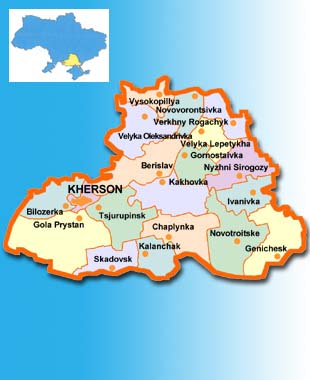
|
Overview of Kherson Oblast
|
The region is divided into 18 rural districts and 3 urban ones in the city of Kherson. There are 9 cities in the region, 30 town-type villages, and 660 rural settlements.
The region is characterized by low concentration of population, with its density being almost twice lower than the average in Ukraine (44 persons per sq. km). Urban dwellers make 61.5% of the population (766,200 persons), while the share of rural dwellers is 38.5% (480,600 persons). There are almost 23% of people under able-bodied age and 57% of work-capable people.
A wonderful climate, the Azov and Black Seas, medicinal mud of Hola Prystan are the basic natural resources of the region.
The length of the region's sea coastline is 120 km.
Adequate climatic conditions and availability of recreation resources have resulted in establishment of a broad network of holiday centers, sanatoriums, and camps for children.
Mineral resources of the region include cement and brick-tile clays, marl, limestone, salt, peat, and natural gas.
ECONOMYThe Kherson region accounts for about 2% of the gross product and the gross value added of Ukraine.
Characteristic of the region is its complex industrial and territorial structure. Of major importance in the formation of the regionís production structure are agriculture and industry accounting for 31% and 16% of the gross value added respectively.
INDUSTRYThe sectoral structure of the regional industry was determined in the 1950s when Kherson Shipbuilding Plant, OSC "Pulp and Paper Integrated Works", OSC "Kherson Cotton Integrated Works", and OSC "Kherson Petroleum Refining Complex" started operation.
The region's industrial performance is considerably affected by the operation of OSC "Kherson Petroleum Refining Complex" producing essential amounts of motor petrol, fuel and other petroleum refining products.
In terms of the domestic and international division and integration of labor, the region specializes in manufacturing electric motors, electric welding instruments, and processing equipment for the agro-industrial sector.
Production of electric machines, equipment, apparatuses, and articles for industrial use accounts for the largest share of the machine-building sector output. OSC "Southern Machine Building Plant" in Nova Kakhovka and OSC "Kakhovka Plant of Electric Welding Equipment" are the most significant enterprises of this branch.
Products of Kherson Shipbuilding Plant, CSC "Kherson Electromechanical Plant", OSC "Kherson Plant of Cardan Shafts", OSC "Beryslav Machine-Building Plant" occupy a firm position in the structure of machine building in the region.
Such enterprises as OSC "Electric Machine-Building Plant" and OSC "Plant of Cardan Shafts" (Kherson), and OSC "Sokil" (Nova Kakhovka) produce spare parts for cars, which are a significant part of their production.
Stock company "Kherson Combines" producing maize combines is one of the leading agricultural machine-building enterprises. The company also manufactures harvesting, irrigation and other machines. A new experimental Ukrainian grain combine KhZS-9M "Slavutych" is being tested for commercial use.
Important is the role of the light industry in the regional industrial structure. Kherson Cotton Plant is the leader of the sector. Footwear and clothes making branches service the needs of the local public.
CSC "Krasen" has established steady relations with its foreign customers. It produces a variety of models of clothing being in great demand.
Food industry is mainly represented by canning, wine-making, confectionery, meat and dairy, flour-grinding, fishery and some other sub-sectors. The most significant food processing enterprises of the region are CSC "Kherson Confectionery", OSC "Kherson Cannery", and OSC "Novotroitsk Food Products".
Ukrainian-Swedish Joint Venture "South Food Inc." has operated in the region since 1996 building up canned food production. The companyís products are in steady demand owing to their high quality and modern packaging.
AGRICULTUREIn terms of production and employment, the agriculture is the basic branch of material production in the region. It occupies 1 700 000 ha of land, including 1 600 000 ha of arable land, of which 29% is irrigated.
The agricultural specialization of the region is determined by its natural geographical conditions. Grains and technical crops are mainly grown in the northern and eastern areas; vegetable growing, horticulture and viticulture are successfully developed in the southern and central areas.
Seven irrigation systems have been constructed in Ingulets, Kakhovka, Rubanivka, Gornostaivka, Zolota Balka, Sofiivka, and Chervonopraporka for a more efficient use of arable lands. Plant growing accounts for 56% and cattle-breeding for 44% of the total commercial production of agriculture.
Grain crops occupy 63% of all sowing areas allowing farmers to obtain a gross gain yield of 3,000,000 tons and to sell at least 1,000,000 tons. The region also has favorable conditions (climate, black and dark brown soils) for growing sunflower. The yield of this crop in some districts reaches 14-15 centners per hectare.
Kherson watermelons weighing up to 12-14 kg are known far beyond the region borders for their sweet and tender taste.
Cattle breeding is oriented to milk production. Chervona Stepova is the main breed grown in the arid climate, which is characterized by high acclimatization potential.
The Askanian fine-fleeced breed prevails in sheep breeding, and Ukrainian steppe white pig in hog breeding.
TRANSPORTA developed network of railways, motor roads, air transport, river and sea ports operates in the Kherson region. A ferry service is in operation.
The total length of motor roads for general use is 5,467 km, including 5,216 km with hard surface. The operational length of railways is 459.4 km, including 84.5 km of electric traction railways and 374.9 km of diesel locomotive traction railways.